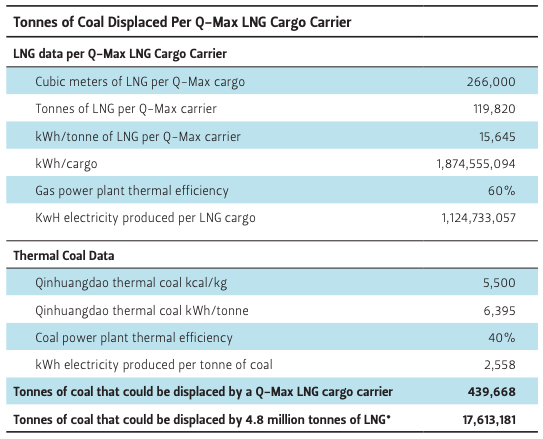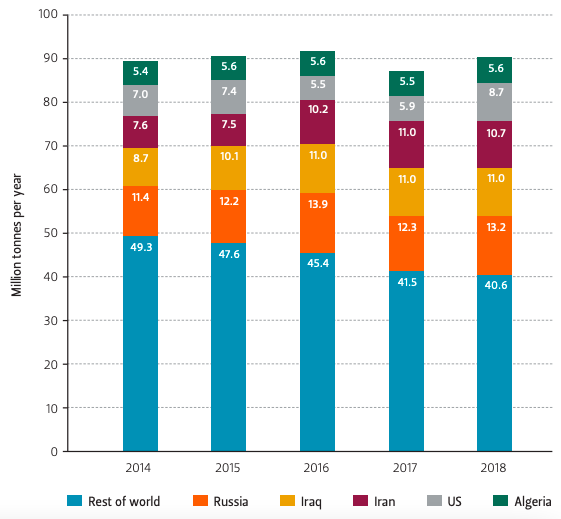Reducing Oilfield Methane Emissions Can Create New US Gas Export Opportunities

Table of Contents
Author(s)
Share this Publication
- Download PDF
- Print This Publication
- Cite This Publication Copy Citation
Collins, Gabriel. 2019. Reducing Oilfield Methane Emissions Can Create New US Gas Export Opportunities. Issue Brief no. 11.19.19. Rice University’s Baker Institute for Public Policy, Houston, Texas.
“Being green while making green” is a winning combination. Actions that improve environmental well-being are most effective and sustainable when they yield a bona fide economic benefit. This certainly would be the case with policies to reduce flaring and venting of natural gas in the US, as doing so would free up gas molecules for export to customers worldwide seeking cleaner, more secure gas supplies. Reducing flaring also helps reduce emissions of carbon dioxide (CO2), fine particulates, and other potentially harmful substances.1 The US has both an opportunity—especially in the Permian Basin—as well as the scale (nearly 1/4 of global natural gas production) to make a global difference by addressing local flaring and venting problems.2
Capturing Flared Gas Could Substantially Boost U.S. LNG Exports
If the gas that analysts estimate was flared in the Permian Basin during the third quarter of 2019 alone was captured and liquefied, it could yield as much as 4.8 million tonnes per year of exportable liquefied natural gas (LNG).3 That volume would exceed the nameplate capacity of a world-class LNG train like what Cheniere Energy has built at its Sabine Pass facility.4 Viewed differently, the gas quantity currently flared in the Permian on an annualized basis equates to more than 15% of the total LNG volume the US exported in 2018.5 This LNG averaged approximately $250/tonne in value, suggesting that capturing the gas now being flared could be a billion dollar per year opportunity—or even larger if LNG prices rise. Gas could be captured and directly fed into Gulf-bound pipelines or could be used to generate power around the Permian Basin, thereby displacing other sources of gas that could then be exported.
Flaring is a lost opportunity with compounding economic and environmental costs as well. Burning gas to heat a home, power an industrial process, or generate electricity all emit CO2, but they also create value. But when gas is flared, CO2 and other combustion products are emitted, and no value is created. If unburned gas is vented, the environmental impacts are even worse since methane (CH4) creates much stronger greenhouse effects than CO2 does. And in either case, the venting or flaring means that society lost an opportunity to supplant coal with cleaner, lower emission natural gas.
At current flaring and venting rates, if all wasted gas in the Permian Basin was captured and liquefied, it could fill a Q-Max LNG carrier (the world’s largest carrier size) every 10 days.6 If that vessel went to China and discharged its cargo into a power plant, it could likely displace approximately 440 thousand tonnes of coal burned to generate electricity (Figure 1).7 Over the course of a year, nearly 18 million tonnes of coal could be displaced using the wasted gas of just one US oil and gas play. Even if US gas did not go directly to China due to barriers erected during the ongoing Sino-American trade war, its presence in the marketplace would free up LNG molecules from other exporters that could then flow to China.
Figure 1 — Potential Coal Displacement From LNG Exports to China

Source Author’s Analysis.
Data from the World Bank suggests that in 2018, petroleum operations across the entire US flared an estimated 14.1 billion cubic meters of gas—equivalent to 8.7 million tonnes per year of LNG (Figure 2). In energy terms, this is equivalent to more than 1/3 of the total LNG volume that US firms actually exported that year.
Figure 2 — Gas Flaring Volume Expressed as LNG Equivalent (Million Tonnes per Year)

Gas Branding?
Certain firms, including Southwestern Energy and BP, are now working to offer consumers “responsibly fracked gas.”8 It remains to be seen if such “green gas,” whether sourced from lower-impact fracking practices or recaptured ahead of a flare stack, can command a sufficient price premium to make the exercise worthwhile.
The present lack of standards to delineate what constitutes “responsibly fracked” gas poses significant challenges. First, it offers wide latitude for producers to creatively brand their gas stream, and it makes it commensurately difficult for consumers to know what they are actually receiving. Furthermore, semantic rebranding alone is likely insufficient to motivate a broad base of consumers to pay a premium for what is ultimately a chemically and thermodynamically undifferentiated CH4 molecule.
Academic studies on consumer willingness to pay for renewable electricity sources may help shed light on how natural gas users might respond to a premium-priced offering of “green gas.” In these analyses, income level was the most consistent predictor across multiple countries and continents of consumer willingness to pay extra for power from wind or solar generators.9
For individual consumers, there are also emotional factors, including the ability to “virtue signal,” that likely help motivate paying above-market rates for energy obtained from producers that market their product as being better for the environment. But for the majority of the population, the concrete virtue of saving money from energy abundance will probably outweigh the more abstract virtue of using greener energy sources. Indeed, the importance of consumer-level energy cost burdens shows up clearly in Deloitte’s “Resources 2019 Study,” which reveals that only about 6% of US electricity customers participate in green energy programs—a number that may actually err on the high side.10
Moreover, the proportion of consumers surveyed who considered the affordability of their total energy bills to be one of their top three energy-related concerns actually rose from 58% in 2018 to 63% in 2019.11 Such attention to cost is very important because it illustrates that many of the same consumers who are willing to pay premiums for products such as foods that differ in quality and enjoyment when consumed (e.g., canned tuna vs. sushi), may not be nearly as willing to do so for fungible products that behave the same way despite a difference in cost (i.e., a lightbulb runs the same whether the energy come from a wind turbine or a coal power station).
For an industrial consumer (particularly heavy industries and manufacturing firms), the calculus is even more straightforward. Costs are existential to many such parties. Furthermore, industrial consumers may not be able to fully pass on energy input costs to customers, especially if the costs were incurred via expenditures on a “green” energy source that customers may not believe necessary or that they may not want to pay for if they can obtain the same good at a lower cost from “non-green” gas.
Policy Challenges and Potential Solutions: Data Transparency Will Be Critical
Flaring and venting of gas in the Permian Basin—and certain other parts of the US—have reached sufficient scale that taken in aggregate, the argument of “burning gas to allow oil extraction” increasingly looks like “wasting one resource to produce another.” Regulators in Texas—the flaring capital of the US—have thus far proven highly deferential to industry on the issue of flared and vented gas, even allowing producers to flare when they are connected to a functional pipeline gathering system.12
Policies to address the flaring challenge need to be data-driven. Better data collection and transparency would facilitate deeper and better-informed public engagement. Key questions such data could answer include: how much is being flared or vented; where is the flaring/ venting taking place; who are the largest emitters; how have their profiles changed over time; and what types and ages of infrastructure account for what percentage of fugitive methane emissions?
One potential model for data collection and dissemination is emerging. The Environmental Defense Fund (EDF) announced in early October 2019 that it is conducting a year-long study of methane emissions throughout the Permian Basin using a range of remote sensors including aerial, tower-based, and vehicle-borne systems, and that it plans to begin releasing data in early 2020.13 Once operationalized, the data collection protocols, sensor suites, data management, and disclosure policies pioneered by observing oilfield infrastructure in the Permian Basin could also be potentially applied in other producing basins and to downstream gas users nationwide, including power plants, transport and distribution pipelines, and petrochemical facilities.
Data transparency and improved domain awareness would help regulators narrow the problem areas and craft tailored solutions that maximize positive impacts while optimizing the burden on industry so as to avoid compromising productive activity. Data transparency would also put pressure on regulatory agencies to acknowledge and more closely regulate activities that affect significant economic interests as well as the broader public welfare, which suffers from the emissions and light pollution caused by flaring and venting of natural gas. Finally, better quantifying the problem can help further minimize the risk and attract additional investors to spur the development of industrial-scale, long-lasting solutions to the gas and flaring challenge throughout US producing basins.
Endnotes
1. “Zero Routine Flaring by 2030,” The World Bank, accessed November 7, 2019, https://www.worldbank.org/en/programs/zero-routine-flaring-by-2030.
2. “Statistical Review of World Energy,” BP, accessed November 7, 2019, https://www.bp.com/en/global/corporate/energy-economics/statistical-review-of-world-energy.html.
3. Jordan Blum, “Permian flaring spikes to new record highs again,” Houston Chronicle, November 6, 2019, https://www.houstonchronicle.com/business/energy/article/Permian-flaring-spikes-to-new-record-highs-again-14813539.php. The LNG tonnage estimate is based on the following arithmetic: (750 million cubic feet/ day ÷ 48,690 cubic feet per tonne of LNG) X 365 days per year X 0.85 to account for gas used in transportation and liquefaction. “LNG industry conversions,” S&P Global Platts, 2017, https://www.platts.com/IM.Platts.Content/MethodologyReferences/ConversionTables/Images/ NGSS1015_LNG_Industry_Conversions_LRG.pdf.
4. “Top 5 Global Supplier of LNG by 2020,” Cheniere, last modified June 2019, https://www.cheniere.com/terminals/sabine-pass/trains-1-6/.
5. “U.S. Natural Gas Exports and Re-Exports by Country,” US Energy Information Administration, September 30, 2019, https://www.eia.gov/dnav/ng/ng_move_expc_s1_a.htm.
6. A Q-Max ship can carry 266,000 cubic meters of LNG (119,820 tonnes of LNG). “Our Fleet,” Nakilat, https://www.nakilat.com/our-fleet/.
7. Assuming: 1) 119,820 tonnes of LNG at 15,645 kWh per tonne energy content; 2) a combined cycle gas power plant efficiency of 60% (“GE Power & Harbin Electric Announce Order for Langfang Gas Combined-Cycle Power Plant Project with SPIC,” GE Reports, January 8, 2018, https://www.genewsroom.com/press-releases/ge-power-harbin-electric-announce-order-langfang-gas-combined-cycle-power-plant); 3) coal energy content of Qinhuangdao benchmark (5,500 kcal/kg or 860 kcal per kWh); and 4) a 40% fleetwide average efficiency rating for coal-fired plants in China.
8. Rebecca Elliot, “’Sustainably Fracked’: Shale Producers Seek a Green Label for Their Natural Gas,” The Wall Street Journal, August 22, 2019, https://www.wsj.com/articles/sustainably-fracked-shale-producers-seek-a-green-label-for-their-natural-gas-11566475200.
9. See, for instance: Kayo Murakami, Takanori Ida, Makoto Tanaka, and Lee Friedman,“Consumers' willingness to pay for renewable and nuclear energy: A comparative analysis between the US and Japan,” Energy Economics 50 (July 2015): 178-189, https://doi.org/10.1016/j.eneco.2015.05.002; Galina Ivanova, “Are Consumers’ Willing to Pay Extra for the Electricity from Renewable Energy Sources? An example of Queensland, Australia,” International Journal of Renewable Energy Research 2, no. 4 (2012): 758-766, https://pdfs.semanticscholar.org/6f3f/6a866972608ca12ea2e36b0a4ea5d1cdfc40.pdf.
10. “Energy management: Balancing climate, cost and choice,” Deloitte Resources 2019 Study, https://www2.deloitte.com/content/dam/insights/us/articles/5065_Global-resources-study/DI_Global-resources-study.pdf. To spot check Deloitte’s assertion, I examined the National Renewable Energy Laboratory’s “Top 10” green power utility data for 2018 (available at https://www.nrel.gov/analysis/assets/pdfs/top-ten-utility-green-pricing-2018.pdf). Five of the largest US utilities—AustinEnergy, Dominion, DTE, National Grid, and Xcel (17.3 million total combined residential electricity customers)—only had about 215,000 customers signed up for green power programs as of December 2018, a participation rate of only 1.2%. Of the top 10 green power utilities, only three had customer participation rates exceeding 10%, and all were located in the Pacific Northwest and served only 1.56 million customers. All other utilities shown had green power customer participation rates of 6.6% or less.
11. “Energy management,” Deloitte Resources 2019 Study.
12. Ryan Collins, “Texas Oil Regulator Shifts Stance as Gas Flaring Hits Record,” Bloomberg, August 7, 2019, https://www.bloomberg.com/news/articles/2019-08-07/texas-oil-regulator-shifts-stance-as-gas-flaring-hits-record.
13. “New Initiative will Map and Measure Methane Emissions Across the Permian Basin,” Environmental Defense Fund, October 2, 2019, https://www.edf.org/media/new-initiative-will-map-and-measure-methane-emissions-across-permian-basin.
This material may be quoted or reproduced without prior permission, provided appropriate credit is given to the author and Rice University’s Baker Institute for Public Policy. The views expressed herein are those of the individual author(s), and do not necessarily represent the views of Rice University’s Baker Institute for Public Policy.



